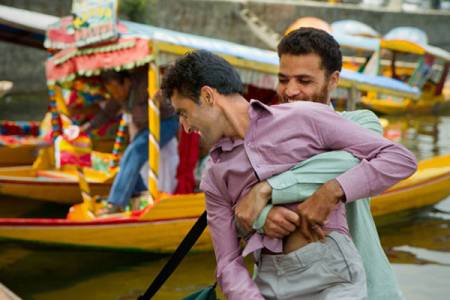 GULZAR BHAT AND MOHAMED AFZAL IN VALLEY OF SAINTSA halcyon bubble that's not, quiteValley of Saints
GULZAR BHAT AND MOHAMED AFZAL IN VALLEY OF SAINTSA halcyon bubble that's not, quiteValley of Saints is a little docudrama set, and beautifully filmed, in endangered lake communities of Kashmir. Content of the film at times seems slight and somewhat meandering, though for some viewers it will make up for this with its handsome cinematography, rich sound design and delicate neorealism knowledgeably rooted in the Kashmiri lake culture and people. The atmosphere is of an idyllic natural world clearly threatened by the dangers of eco-destruction and political violence. The decisive event is a a military curfew imposed to block local protesters. In particular it temporarily stops the two protagonists, a pair of playful 20-something best friends, Gulzar (Gulzar Bhat ) and Afzal (Mohamed Afzal), from carrying out their plan of escaping local economic deprivation to seek their fortunes elsewhere, presumably Delhi. In this temporary bubble, they're thrown together with Asifa (Neelofar Hamid), houseboat guest of a relative, a young ex-pat female environmental scientist studying pollution of the lake. An initial character is the elderly uncle Gulzar lives with, who goes off to a wedding; his return at the end rhythmically bookends the tale. The two friends, whose affection for each other is so intimate that in American culture it might be considered homoerotic, react differently to Asifa, whose attraction causes enmity between them.
Syeed's neorealism is tempered by pastel colors and sweet, lilting transitional guitar music between scenes, but there is a slightly haggard quality to the two young men's faces. This is in spite of their playfulness, which
Times's Stephen Holden identified in his review as revealing them to be "stuck in a kind of permanent adolescence born of poverty, lack of education and a puritanical Islamic culture." Under the circumstances, this might not be such a bad place to be. But the curfew-imposed stagnation is a telling metaphor for how Gulzar and Afzal seem frozen in time and place, and in a place that is a certifiably doomed paradise. Asifa explains how Lake Dal, once thought of as a valley protected by saints, is steadily deteriorating, already to some extent beyond repair. It could be on the way to becoming like the world described in Hubert Sauper's
Darwin's Nightmare.
The climax is the rivalry between Gulzar and Afzar for the affections of the Kashmiri-American Asifa, which Gulzar seems to be winning, if only in a very chaste way. Being a skilled shikara wala or tourist boatman, he gets to take Asifa around the lake for the week of the curfew, before Ramadan, and impresses her with his awards and poems and his little attentions. His time with her may lead Gulzar to dreaming for a moment of a larger world that might open up to him through Asifa, were he not lacking in education and so rooted in this place.
Valley of Saints is delicately beautiful and suggestive in many ways, but its documentary elements, its cinematography and local color, threaten to swamp its narrative at times. Syeed has trouble subordinating some elements of his film -- the lake, the violence, the friendship, the attraction to the woman, the desire to escape -- to Gulzar's story. Syeed's lingering documentary impulses seem to hamper him a little from telling a strong story. This is not Renoir, De Sica, or Satyajit Ray, though the raw materials for their kind of film seem to be here, and may come together another time for this talented team. Things do finally speed up in the last fifteen minutes and tie up the story neatly and touchingly.
Musa Syeed's six credits are wide-ranging, including a child in revolutionary Yemen; a girl returning from the Bronx to Africa; Muslim, Catholic, and Jewish seminarians; work in a NYC halal slaughterhouse. Two of these, shown on the PBS Independent Lens and POV series, were made in collaboration with fellow NYU-educated photographer Yoni Brook, who also photographed this first feature. Syeed is himself an American of Kashmiri descent. His father left the homeland after being imprisoned for his involvement in the independence movement.
Valley of Saints, 82 mins., in Kashmiri with English subtitles, debuted at Sundance January 2012, winning two awards and nominated for a third. It won other festival awards. Shown at over a half dozen international festivals, opening in German theaters a year later. US release 9 January 2015 (Quad Cinema, NYC). Metacritic rating 85%; a
New York Times Critics Pick.





